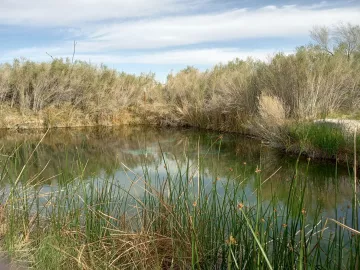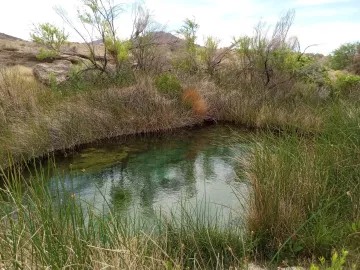By Linda Stout
Ash Meadows National Wildlife Refuge is a natural resource with environmental significance too important to risk. In January of 2023, Rover Metals notified the Bureau of Land Management (BLM) of its plans to conduct exploratory drilling for lithium on public lands immediately adjacent to the refuge. The Sierra Club acknowledges that lithium plays an important role in the transition to clean technologies, including the transition to clean transportation. However, the Sierra Club also supports the Endangered Species Act and wants to work with BLM to ensure that lithium exploration does not cause irreparable and unnecessary harm to unique and protected habitats in the process.
Ash Meadows is located directly east of Death Valley National Park in Nevada’s Amargosa Valley and is the ancestral lands of the Timbisha Shoshone (Newe) and Southern Paiute (Nuwuvi). This culturally sensitive wetlands has sustained wildlife and humans for thousands of years and is considered a biological “hotspot” that provides critical habitat for more than 25 rare plants and animal species, 12 of which are protected under the Endangered Species Act as threatened or endangered. Its network of nearly 600-square miles of natural springs and aquifers supports the highest concentration of endemic species – those found in only one location – anywhere in the United States, with some species dating back to the pleistocene era.
Designated as an Area of Critical Environmental Concern (ACEC), Ash Meadows is the fourth wetland in the United States to be designated as a Ramsar site, one of over 2,000 wetlands worldwide that are protected under an intergovernmental treaty known as the Convention on Wetlands. The agreement is meant to ensure that governments effectively manage “conservation and wise use of wetlands and their resources.”
Mining practices have often been harmful in this region. Peat mining during the early 1960s destroyed roughly 2000 acres of vital wetlands at Carson Slough in Ash Meadows. In 1967, the Stauffer Chemical Company drilled an exploratory borehole to the depth of 360 feet near the intersection of the Tecopa Spring and the Amargosa River, just south of the Refuge. They punctured a deep carbonate aquifer, and hot spring water bubbled up and formed the Bore Hole Spring. Attempts to plug and backfill the borehole failed. Ultimately it remained uncapped, creating an unintended man-made artesian spring-fed marsh.
The impact on wildlife was not insignificant. In the weeks following the borehole incident, the endangered Amargosa pupfish from the Amargosa River made a home in this newly formed habitat. Today, the Amargosa pupfish remains endangered and has grown smaller, likely due to the warming conditions produced by the introduction of hot spring water into the Amargosa River. The Tecopa pupfish, endemic to the hot spring, was not so fortunate. Failing to adapt to its altered environment, it was the first official organism on the endangered species list to go extinct.
While the land selected by Rover Metals for exploratory drilling of lithium may technically lie outside the Ash Meadows Wildlife Refuge ACEC, the water flowing beneath it is one massive interconnected body of water. The Amargosa Desert north of Ash Meadows is known to have “shallow carbonate rocks.” Rover Metals is projected to drill 30 boreholes to a depth of 300 feet, much like the Stauffer Chemical Company did at Tecoma Spring in 1967. Exploratory drilling could once again disturb crucial groundwater flows connected to the Amargosa River, causing habitat loss for the endangered Amargosa pupfish and Speckled Dace, migratory birds, and rare species endemic to the Ash Meadows.
Wetlands support diverse ecosystems and provide all of our fresh water, yet they are often degraded and converted to other uses. Allowing exploratory drilling in or near a designated Ramsar site, even for minerals of critical need like lithium, could potentially violate the intergovernmental treaty. To ensure that exploratory drilling does not negatively impact groundwater-dependent ecosystems that lie beneath Ash Meadows, the Sierra Club has requested that BLM prepare an environmental assessment prior to drilling. It should include a detailed hydrologic study and a contingency plan for an artesian flow. Lithium has an important role in advancing renewable energy technologies, but it should not come at the expense of endangering ancestral lands and fragile ecosystems.

|

|